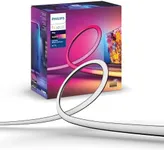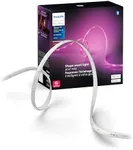Buying Guide for the Best Led Strips
Choosing the right LED strip lights can make a big difference in the atmosphere and functionality of your space. Whether you want to add accent lighting, brighten up a workspace, or create a colorful ambiance, understanding the key features of LED strips will help you make a smart choice. It's important to think about where you'll use the lights, what kind of mood or effect you want, and how much control you need over brightness and color. By focusing on the main specifications, you can find an LED strip that fits your needs perfectly.Brightness (Lumens)Brightness, measured in lumens, tells you how much light the LED strip will produce. This is important because it affects how well the strip will illuminate your space. Lower brightness (under 300 lumens per meter) is good for accent lighting or subtle effects, while medium brightness (300-700 lumens per meter) works well for under-cabinet lighting or general room accents. High brightness (over 700 lumens per meter) is best for task lighting or areas that need to be well-lit. Think about whether you want a soft glow or strong illumination, and choose the brightness level that matches your purpose.
Color TemperatureColor temperature describes the color of the light, ranging from warm (yellowish) to cool (bluish) tones, measured in Kelvins (K). Warm white (2700K-3000K) creates a cozy, relaxing feel, ideal for living rooms or bedrooms. Neutral white (3500K-4500K) is more balanced and works well in kitchens or workspaces. Cool white (5000K-6500K) is bright and energizing, suitable for garages or task areas. Consider the mood you want to set and the room's function when picking the color temperature.
Color Options (RGB, RGBW, Single Color)LED strips come in different color options: single color (just one shade, usually white), RGB (red, green, blue for color-changing effects), and RGBW (RGB plus a dedicated white LED for better white light). Single color strips are simple and great for straightforward lighting needs. RGB strips let you change colors for mood or decoration, while RGBW strips offer both color-changing and high-quality white light. If you want flexibility and fun, go for RGB or RGBW; if you just need basic lighting, single color is enough.
Water Resistance (IP Rating)The IP rating tells you how well the LED strip is protected against dust and water. For indoor use in dry areas, a basic IP20 rating is fine. For kitchens, bathrooms, or outdoor use, look for higher ratings like IP65 (splash-proof) or IP67/IP68 (waterproof). Think about where you’ll install the strip and whether it might get wet or dirty, and choose an IP rating that matches those conditions.
Length and Cuttable SegmentsLED strips come in various lengths, and many can be cut at marked points to fit your space exactly. This is important for customizing the installation to your needs. If you have a specific area to light, measure it first and check if the strip can be cut or extended. Make sure the strip you choose can be adjusted to fit your project without leaving gaps or wasting material.
Power Source and VoltageLED strips run on different voltages, commonly 12V or 24V, and need a compatible power supply. The voltage affects how far the strip can run without losing brightness. For short runs, 12V is usually fine, but for longer installations, 24V is better to maintain even lighting. Always check what power supply is needed and make sure it matches your setup. This ensures safety and reliable performance.
Control Options (Remote, App, Smart Home Integration)Control options let you adjust brightness, color, and effects. Some strips use a simple remote, while others can be controlled by a smartphone app or integrated with smart home systems like Alexa or Google Home. If you want to automate your lighting or control it from your phone, look for smart features. If you prefer simplicity, a basic remote may be all you need. Choose the control method that fits your lifestyle and tech comfort level.
Adhesive Backing and MountingMost LED strips have adhesive backing for easy installation, but the quality can vary. Some also come with mounting clips for extra security. If you’re installing on a smooth, clean surface, adhesive may be enough. For rough or tricky spots, or if you want a more permanent setup, look for strips with strong adhesive or included mounting hardware. Consider where and how you’ll mount the strip to ensure it stays in place.



















